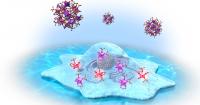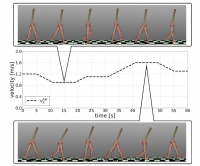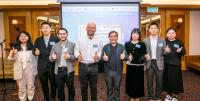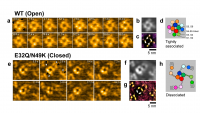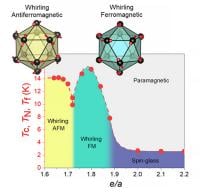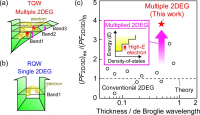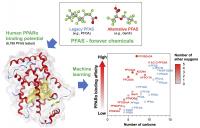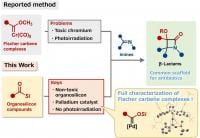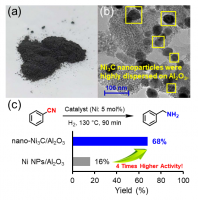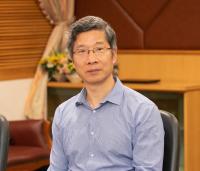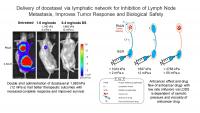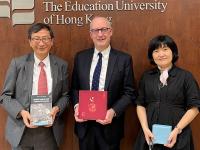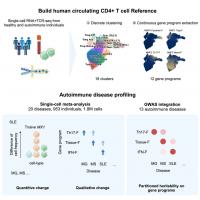Content is provided by our community of institutions, partners, researchers and journalists.
Hokkaido University
22 Jan 2024
A water-soluble, luminescent europium complex enables evaluation of malignancy grade in model glioma tumor cells.
Tohoku University
22 Jan 2024
We may not think about it while doing it, but our nervous system is directing our bones, joints, muscles, tendons, and more to move as efficiently as possible at varying speeds. Replicating this in robots is notoriously difficult. But now, Tohoku University researchers have created a model that makes this possible, thanks in large part to an innovative algorithm.
Lingnan University (LU)
20 Jan 2024
Lingnan University held the kick-off ceremony for the 2nd Postgraduate Mentorship Programme on campus today (20 January). About 200 postgraduate students and mentors attended the event, which helps graduating students navigate employment challenges in Hong Kong's rapidly evolving and competitive environment. The programme shows mainland Chinese and overseas non-local students how to adapt strategically to Hong Kong's culture, make smart career choices, and unleash their full potential in the job market.
Asia Research News
19 Jan 2024
Asia Research News monitors the latest research news in Asia. Some highlights that caught our attention this week are watching plants warn each other of danger, how even “harmless” addictions can have a serious side effects, and how to clear roads and railways faster using gold nanorods.

Hokkaido University
19 Jan 2024
Temperature-controlled, reversible shifting of molecular gear motion in a solid crystal opens new possibilities for material design.
Academia Sinica
19 Jan 2024
A recent paper published in the journal Astronomy & Astrophysics presents new images from the 2018 data that reveal a familiar ring the same size as observed in 2017. This bright ring surrounds a deep central depression, “the shadow of the black hole,” as predicted by general relativity. Excitingly, the peak brightness of the ring has shifted by about 30º counter clockwise compared to its position in 2017, which is consistent with our theoretical understanding of the variability of the turbulent material around black holes.
Lingnan University (LU)
18 Jan 2024
Lingnan University’s School of Graduate Studies recently invited Dr Miguel Antonio Lim, Senior Lecturer in Education and Research Excellence Framework (REF) coordinator at the Manchester Institute of Education, to deliver a thought-provoking presentation on “Ethical Internationalisation in Higher Education and the Need for Understanding ‘South-to-South’ Student Mobility” at a seminar. Dr Lim is well-known for his extensive research in international and transnational higher education.
Tohoku University
18 Jan 2024
Researchers at Tohoku University have developed guidelines for a single-nanometer magnetic tunnel junction (MTJ), allowing for performance tailoring to meet the requirements of diverse applications, ranging from AI/IoT to automobiles and space technologies.
Osaka Metropolitan University
18 Jan 2024
A research group led by Osaka Metropolitan University has discovered significant nonreciprocal optical absorption of LiNiPO4, referred to as the optical diode effect, in which divalent nickel (Ni2+) ions are responsible for magnetism, by passing light at shortwave infrared wavelengths used in optical communications. Furthermore, they have uncovered that it is possible to switch the optical diode effect by applying a magnetic field. This is a step forward in the development of an innovative optical isolator that is more compact and can control light propagation, replacing the conventional optical isolators with complex structures
Kanazawa University
18 Jan 2024
Researchers at Nano Life Science Institute (WPI-NanoLSI), Kanazawa University report in Nature Communications a high-speed atomic force microscopy study of the structural dynamics of sodium ion channels in cell membranes. The findings provide insights into the mechanism behind the generation of cell-membrane action potentials.
Tohoku University
18 Jan 2024
Non-Heisenberg-type approximant crystals have many interesting properties and are intriguing for researchers of condensed matter physics. However, their magnetic phase diagrams, which are crucial for realizing their potential, remain completely unknown. Now, for the first time, a team of researchers has constructed the magnetic phase diagram of a non-Heisenberg Tsai-type 1/1 gold-gallium-terbium approximant crystal. This development marks a significant step forward for quasicrystal research and for the realization of magnetic refrigerators and spintronic devices.
Kanazawa University
17 Jan 2024
Researchers at Nano Life Science Institute (WPI-NanoLSI), Kanazawa University report in Nano Letters how the flexibility of a protein hinge plays a crucial role in the transfer of proteins in key cell processes.
Osaka University
17 Jan 2024
Researchers from Osaka University have discovered a novel treatment to relieve cytokine release syndrome (CRS), a life-threatening inflammation triggered by a serious infection or severe burn. Treatment with a short-acting antibody reduces the inflammatory effects of interleukin-6, a key cytokine in CRS while avoiding the side effects associated with previous longer-acting therapies.
Osaka University
16 Jan 2024
Researchers from Osaka University developed a bio-logger for seabirds that enables long-term observation of rare behaviors. The bio-logger employs low-power depth sensors and accelerometers to identify rare behavior using a light-weight outlier detection model and records the behavior in a 5-min video. Observations using the bio-loggers on Streaked Shearwaters revealed novel aspects of head-shaking and foraging strategies. This approach will enable a wider range of animal behaviors in various environments to be observed.
Osaka University
16 Jan 2024
Researchers from Osaka University and collaborating partners have improved the efficiency of heat-to-electricity conversion in gallium arsenide semiconductor microstructures. By judicious spatial alignment of electrons within a two-dimensional electron gas system with multiple subbands, one can substantially enhance the power factor compared with previous iterations of analogous systems. This work is an important advance in modern thermoelectric technology and will benefit the global integration of the Internet of Things.
Ehime University
16 Jan 2024
7000 forever chemicals (PFAS) and human PPARa binding properties predicted using AI technology
Osaka University
16 Jan 2024
Researchers from Osaka University have simplified the operation of an important class of chemical transformation: synthesis of beta-lactams, the intricate scaffold of many antibiotics. Their experimental protocol minimizes the toxicity that is a common feature of similar Fischer-carbene synthetic methodologies, and was used to synthesize the scaffold of the thienamycin antibiotic in high yield. This work is an important advancement in sustainable chemistry that should benefit drug development and other chemical syntheses.
Osaka University
15 Jan 2024
Researchers from Osaka University and collaborating partners have helped minimize the cost of an important class of chemical transformations: converting nitriles into primary amines. Their experimental protocol uses a cheap nickel catalyst instead of an expensive noble metal, is convenient to conduct, and works for a broad range of starting materials. This work is an important advance in sustainable chemistry that might help lower the cost of producing nylon and many other everyday products.
Nanyang Technological University
15 Jan 2024
Research by Assistant Professor Edison Ang Huixiang and his team from National Institute of Education/Nanyang Technological University Singapore
MAP Academy
15 Jan 2024
The Punjab regions of India and Pakistan bear witness to a centuries-old, laborious tradition of embroidering cloth with silk threads. Called Vari da Bagh and Bagh, meaning “‘garden”’, these textiles are ritually significant and are adorned with geometric patterns or motifs that draw from the everyday life and culture of the region.
Asia Research News
15 Jan 2024
Unleashing stem cells from dog urine, Electronic Tongue, Tapping into human motion energy, How neurons network, and A radical use for plastic bags. Plus Communicating science two decades on. Read all in the latest Editor's Choice.
Lingnan University (LU)
14 Jan 2024
The Council of Lingnan University approved the Search Committee’s recommendation to appoint Prof Yao Xin as Vice-President (Research and Innovation) and concurrently Tong Tin Sun Chair Professor of Machine Learning, effective from 22 January 2024, for a term of five years. Prof Yao is also appointed as Tong Tin Sun Chair Professor of Machine Learning and will oversee and steer the development of research, innovation and knowledge transfer at the University, and provide leadership for the research institutes and centres with the Associate Vice-President (Strategic Research). He will oversee the School of Graduate Studies and the Office of Research and Knowledge Transfer directly.
Asia Research News
12 Jan 2024
Asia Research News monitors the latest research news in Asia. Some highlights that caught our attention this week are how a King Kongesque ape went extinct, how antibodies can make you dizzy, and a material that can break down harmful chemicals using the sun.
Tohoku University
12 Jan 2024
Much is known about the added complication to pregnancy when it comes to the age of the mother, but recent studies show that the age of the father can also heighten the risk of neurodevelopmental disorders. A team of researchers has explored the impacts of paternal aging on microRNAs, the molecules that play a crucial role in regulating gene expression.
Tohoku University
12 Jan 2024
Tohoku University researchers have unveiled a new approach to treating lymph node metastasis. The process invovled administering anticancer drugs directly into the lymph nodes, producing better outcomes and lessening the side effects commonly associated with cancer treatment.
Institute of Industrial Science, The University of Tokyo (UTokyo-IIS)
11 Jan 2024
Researchers at the Institute of Industrial Science, The University of Tokyo create customizable polymer molds to produce cost-effective arrays of microneedles that can be used to uniquely identify pets with alphanumeric symbols instead of tags or collars.
The Education University of Hong Kong (EdUHK)
11 Jan 2024
The Education University of Hong Kong (EdUHK) announced the establishment of a new collaborative research network with the Institute of Education (IOE), University College London (UCL) – an institution which has been recognised as the top-ranked institution in the discipline of Education & Training by the QS World University Rankings every year since 2014.
Osaka University
11 Jan 2024
Researchers from Osaka University found that CD4+ T cells can be classified into 18 categories and 12 distinct gene programs, and that characteristic changes in CD4+ T cell profiles are associated with autoimmune disease, sex, and aging. Analysis of these distinctive immune cell profiles could be used to predict autoimmune disease in the future, paving the way for precision medicine.
Osaka University
11 Jan 2024
Researchers from SANKEN (The Institute of Scientific and Industrial Research), at Osaka University, Shizuoka Institute of Science & Technology, and collaborating partners have resolved a problem that has limited the environmental sustainability of peracid synthesis. By judicious choice of the solvent and light input, approximately room-temperature autoxidation of aldehydes proceeds in a manner that results in industrially useful peracids or carboxylic acids. This work is an important advance in green chemistry that will help minimize the carbon footprint of the chemical industry.
Osaka University
10 Jan 2024
A research team from Osaka University, The University of Tokyo, and Tokyo Institute of Technology revealed the microscopic origin of the large magnetoelectric effect in interfacial multiferroics composed of the ferromagnetic Co2FeSi Heusler alloy and the piezoelectric material. They observed element-specific changes in the orbital magnetic moments in the interfacial multiferroic material using an X-ray Magnetic Circular Dichroism (XMCD) measurement under the application of an electric field, and they showed the change contributes to the large magnetoelectric effect. The findings provide guidelines for designing materials with a large magnetoelectric effect, and it will be useful in developing new information writing technology that consumes less power in spintronic memory devices. The research results will be shown in an article, “Strain-induced specific orbital control in a Heusler alloy-based interfacial multiferroics” published in NPG Asia Materials.


